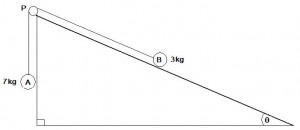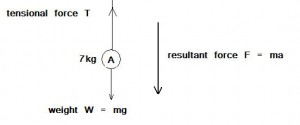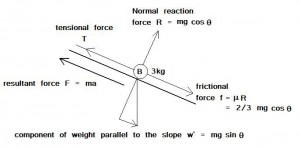Vector Mechanics questions are relatively easy to answer, yet it causes a great deal of confusion in the minds of students.
Here is the method that I use to solve the questions on vector mechanics. I will use the example below.
Example
Two particles A and B, of mass 7 kg and 3 kg respectively, are attached to the ends of a light inextensible string. Initially B is held at rest on a rough fixed plane inclined at angle θ to the horizontal, where tan θ = 5/12. The part of the string from B to P is parallel to a line of greatest slope of the plane. The string passes over a small smooth pulley, P, fixed at the top of the plane. The particle A hangs freely below P, as shown in Fig. 1. The coefficient of friction ‘μ’ between B and the plane is 2/3. The particles are released from rest with the string taut and B moves up the plane.
Calculate the magnitude of the acceleration of B immediately after release.
Solution
First of all I will draw a situation diagram as shown here.
Now, let us consider the particle A:
The diagram on the left shows all the forces acting on the particle A. Since the particle ‘A’ is moving downwards, the resultant force ‘F’ on it will be also acting downwards.
We, therefore, have
F = W – T
ma = mg – T
Substituting the values for ‘m’ gives 7a = 7g – T equation (1)
Now, let us consider particle B:
This diagram shows all the forces acting on the particle B. The expressions for the normal reaction force ‘R’, the frictional force ‘f’ and the downward component of the weight ‘W’ ‘parallel to the slope are given by the expressions shown in the diagram. Since the particle B is moving upwards, the resultant force ‘F’ is upwards and, therefore, we have
F = T – W’ – f
ma = T – mg sin θ – μR
ma = T – mg sin θ – μ mg cos θ
Given that μ = 2/3 and that tan θ = 5/12, we can deduce sin θ = 5/13 and cos θ = 12/13.
Substituting appropriate values and taking g = 9.81 ms^-2, we have
3a = T – 3g (5/13) – (2/3) 3g (12/13)
3a = T – 15g/13 – 24g/13 = T – 39g/13 equation (2)
Using equations (1) and (2) to eliminate T, yields
10a = 7g – 39g/13
a = 3.924 ms-2 or 3.9 ms^-2 (1 d.p.)
Thus, the particle B has an initial acceleration at 3.9 ms^-2 immediately after its release.
Remarks
To help you answer the questions correctly in exams, it is very important to show how the forces are resolved using clear labelled diagrams. Also, it is advisable to simplify the mathematical expressions before substituting the numerical values. This will help you avoid carrying large decimal values forward for further calculations, and introduce large errors in your final answer.
For further help in mechanics or to learn new topics physics, book your tuition now, or call us on 079 5655 8523.



